NAB Job Cuts & Digitalization: An Analysis Using Accounting Theories
VerifiedAdded on 2023/06/12
|8
|1844
|368
Essay
AI Summary
This essay examines the National Australia Bank (NAB) case study, focusing on the bank's decision to cut 6,000 jobs amidst a $5.3 billion profit. The analysis attributes the job cuts to digitalization in banking operations, as stated by NAB's Chief Executive. The essay relates these decisions to accounting theories, primarily stakeholder theory and positive accounting theory (PAT). Stakeholder theory highlights the impact on employees, the local community, and customers, while PAT explains NAB's cost-cutting strategy to maximize efficiency. The essay also touches on the theory of Renewed Financialisation, linking job cuts to the need for capital investment in digitalization. Ultimately, the analysis suggests that while both stakeholder and positive accounting theories are relevant, the stakeholder theory is more crucial for NAB, emphasizing the importance of considering the well-being of all stakeholders, especially employees, during restructuring.
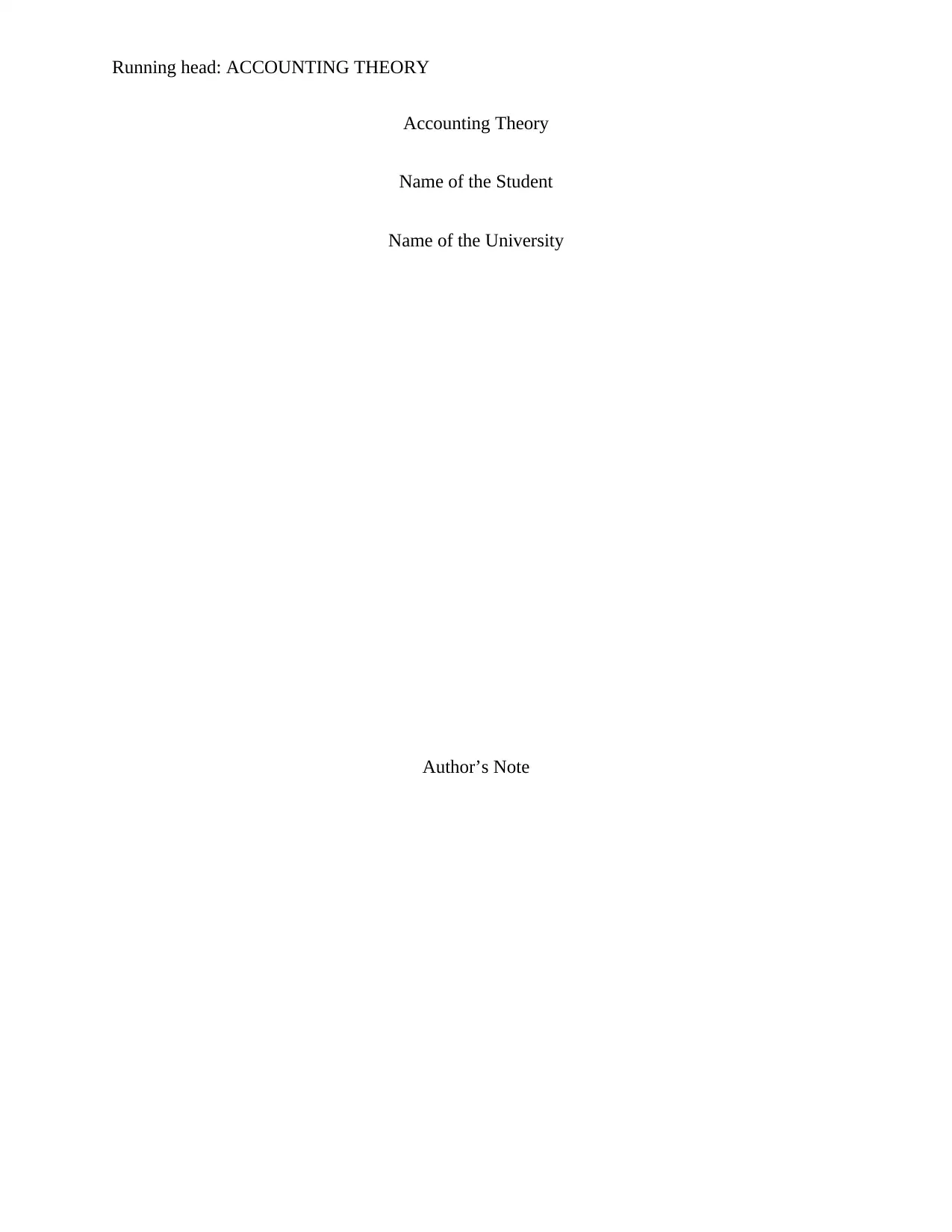
Running head: ACCOUNTING THEORY
Accounting Theory
Name of the Student
Name of the University
Author’s Note
Accounting Theory
Name of the Student
Name of the University
Author’s Note
Paraphrase This Document
Need a fresh take? Get an instant paraphrase of this document with our AI Paraphraser
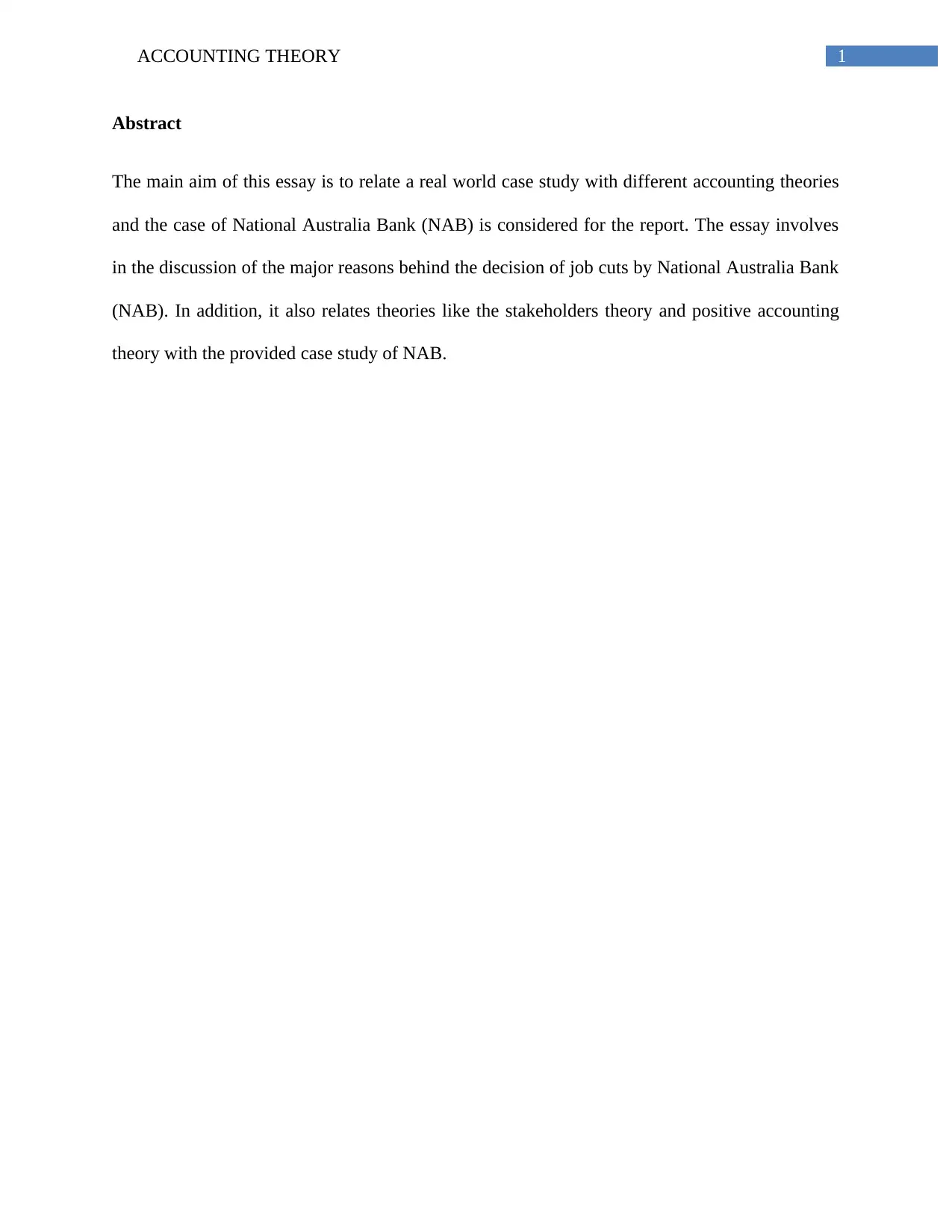
1ACCOUNTING THEORY
Abstract
The main aim of this essay is to relate a real world case study with different accounting theories
and the case of National Australia Bank (NAB) is considered for the report. The essay involves
in the discussion of the major reasons behind the decision of job cuts by National Australia Bank
(NAB). In addition, it also relates theories like the stakeholders theory and positive accounting
theory with the provided case study of NAB.
Abstract
The main aim of this essay is to relate a real world case study with different accounting theories
and the case of National Australia Bank (NAB) is considered for the report. The essay involves
in the discussion of the major reasons behind the decision of job cuts by National Australia Bank
(NAB). In addition, it also relates theories like the stakeholders theory and positive accounting
theory with the provided case study of NAB.
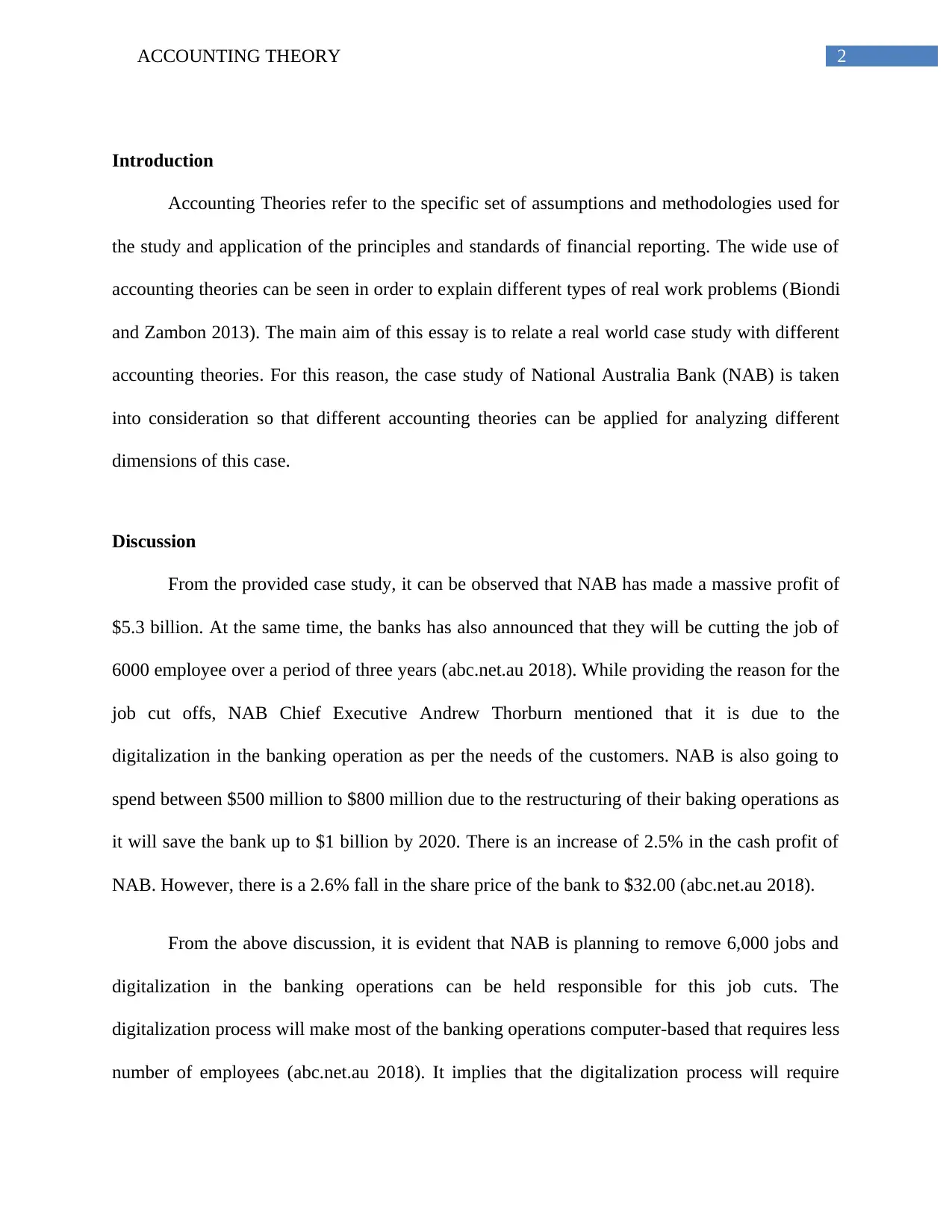
2ACCOUNTING THEORY
Introduction
Accounting Theories refer to the specific set of assumptions and methodologies used for
the study and application of the principles and standards of financial reporting. The wide use of
accounting theories can be seen in order to explain different types of real work problems (Biondi
and Zambon 2013). The main aim of this essay is to relate a real world case study with different
accounting theories. For this reason, the case study of National Australia Bank (NAB) is taken
into consideration so that different accounting theories can be applied for analyzing different
dimensions of this case.
Discussion
From the provided case study, it can be observed that NAB has made a massive profit of
$5.3 billion. At the same time, the banks has also announced that they will be cutting the job of
6000 employee over a period of three years (abc.net.au 2018). While providing the reason for the
job cut offs, NAB Chief Executive Andrew Thorburn mentioned that it is due to the
digitalization in the banking operation as per the needs of the customers. NAB is also going to
spend between $500 million to $800 million due to the restructuring of their baking operations as
it will save the bank up to $1 billion by 2020. There is an increase of 2.5% in the cash profit of
NAB. However, there is a 2.6% fall in the share price of the bank to $32.00 (abc.net.au 2018).
From the above discussion, it is evident that NAB is planning to remove 6,000 jobs and
digitalization in the banking operations can be held responsible for this job cuts. The
digitalization process will make most of the banking operations computer-based that requires less
number of employees (abc.net.au 2018). It implies that the digitalization process will require
Introduction
Accounting Theories refer to the specific set of assumptions and methodologies used for
the study and application of the principles and standards of financial reporting. The wide use of
accounting theories can be seen in order to explain different types of real work problems (Biondi
and Zambon 2013). The main aim of this essay is to relate a real world case study with different
accounting theories. For this reason, the case study of National Australia Bank (NAB) is taken
into consideration so that different accounting theories can be applied for analyzing different
dimensions of this case.
Discussion
From the provided case study, it can be observed that NAB has made a massive profit of
$5.3 billion. At the same time, the banks has also announced that they will be cutting the job of
6000 employee over a period of three years (abc.net.au 2018). While providing the reason for the
job cut offs, NAB Chief Executive Andrew Thorburn mentioned that it is due to the
digitalization in the banking operation as per the needs of the customers. NAB is also going to
spend between $500 million to $800 million due to the restructuring of their baking operations as
it will save the bank up to $1 billion by 2020. There is an increase of 2.5% in the cash profit of
NAB. However, there is a 2.6% fall in the share price of the bank to $32.00 (abc.net.au 2018).
From the above discussion, it is evident that NAB is planning to remove 6,000 jobs and
digitalization in the banking operations can be held responsible for this job cuts. The
digitalization process will make most of the banking operations computer-based that requires less
number of employees (abc.net.au 2018). It implies that the digitalization process will require
⊘ This is a preview!⊘
Do you want full access?
Subscribe today to unlock all pages.

Trusted by 1+ million students worldwide
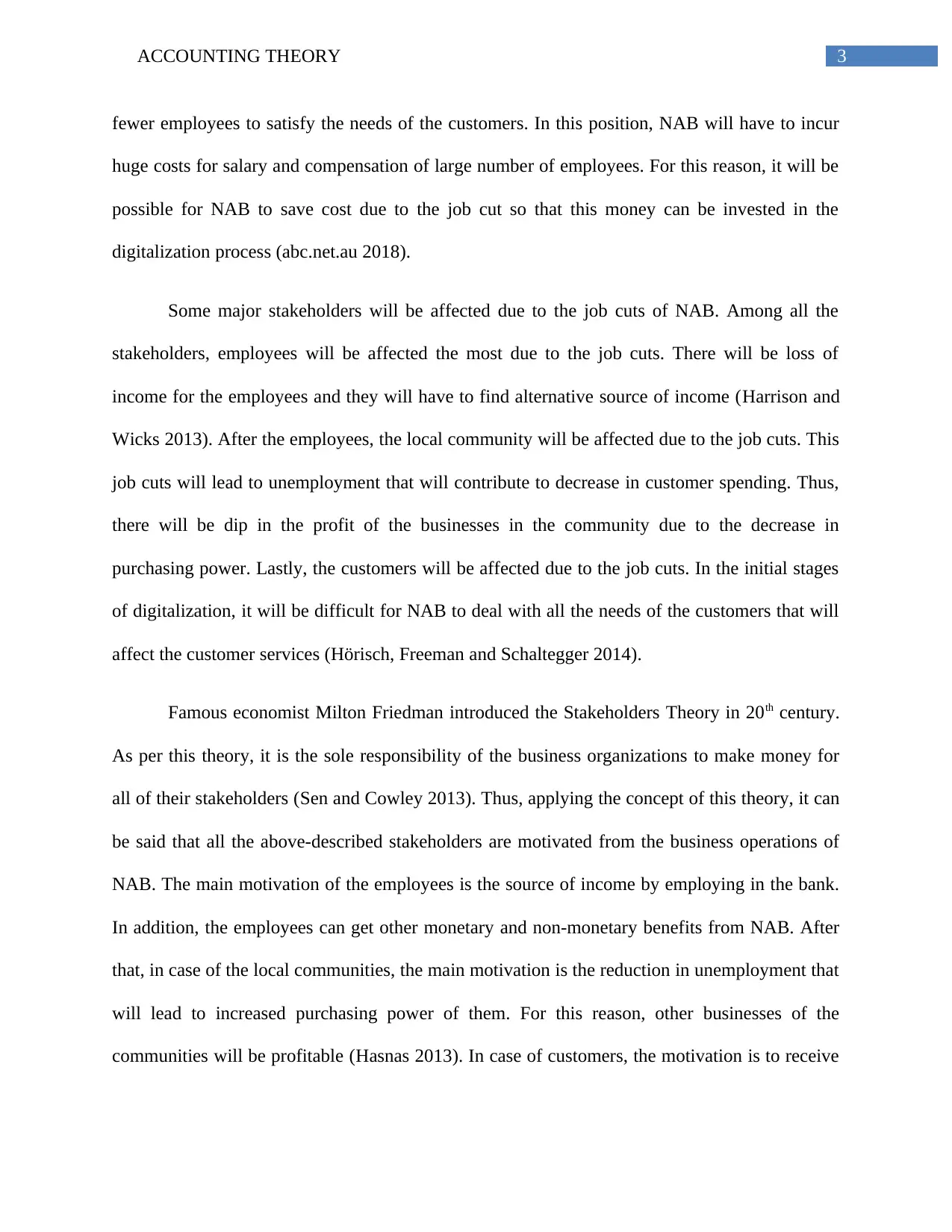
3ACCOUNTING THEORY
fewer employees to satisfy the needs of the customers. In this position, NAB will have to incur
huge costs for salary and compensation of large number of employees. For this reason, it will be
possible for NAB to save cost due to the job cut so that this money can be invested in the
digitalization process (abc.net.au 2018).
Some major stakeholders will be affected due to the job cuts of NAB. Among all the
stakeholders, employees will be affected the most due to the job cuts. There will be loss of
income for the employees and they will have to find alternative source of income (Harrison and
Wicks 2013). After the employees, the local community will be affected due to the job cuts. This
job cuts will lead to unemployment that will contribute to decrease in customer spending. Thus,
there will be dip in the profit of the businesses in the community due to the decrease in
purchasing power. Lastly, the customers will be affected due to the job cuts. In the initial stages
of digitalization, it will be difficult for NAB to deal with all the needs of the customers that will
affect the customer services (Hörisch, Freeman and Schaltegger 2014).
Famous economist Milton Friedman introduced the Stakeholders Theory in 20th century.
As per this theory, it is the sole responsibility of the business organizations to make money for
all of their stakeholders (Sen and Cowley 2013). Thus, applying the concept of this theory, it can
be said that all the above-described stakeholders are motivated from the business operations of
NAB. The main motivation of the employees is the source of income by employing in the bank.
In addition, the employees can get other monetary and non-monetary benefits from NAB. After
that, in case of the local communities, the main motivation is the reduction in unemployment that
will lead to increased purchasing power of them. For this reason, other businesses of the
communities will be profitable (Hasnas 2013). In case of customers, the motivation is to receive
fewer employees to satisfy the needs of the customers. In this position, NAB will have to incur
huge costs for salary and compensation of large number of employees. For this reason, it will be
possible for NAB to save cost due to the job cut so that this money can be invested in the
digitalization process (abc.net.au 2018).
Some major stakeholders will be affected due to the job cuts of NAB. Among all the
stakeholders, employees will be affected the most due to the job cuts. There will be loss of
income for the employees and they will have to find alternative source of income (Harrison and
Wicks 2013). After the employees, the local community will be affected due to the job cuts. This
job cuts will lead to unemployment that will contribute to decrease in customer spending. Thus,
there will be dip in the profit of the businesses in the community due to the decrease in
purchasing power. Lastly, the customers will be affected due to the job cuts. In the initial stages
of digitalization, it will be difficult for NAB to deal with all the needs of the customers that will
affect the customer services (Hörisch, Freeman and Schaltegger 2014).
Famous economist Milton Friedman introduced the Stakeholders Theory in 20th century.
As per this theory, it is the sole responsibility of the business organizations to make money for
all of their stakeholders (Sen and Cowley 2013). Thus, applying the concept of this theory, it can
be said that all the above-described stakeholders are motivated from the business operations of
NAB. The main motivation of the employees is the source of income by employing in the bank.
In addition, the employees can get other monetary and non-monetary benefits from NAB. After
that, in case of the local communities, the main motivation is the reduction in unemployment that
will lead to increased purchasing power of them. For this reason, other businesses of the
communities will be profitable (Hasnas 2013). In case of customers, the motivation is to receive
Paraphrase This Document
Need a fresh take? Get an instant paraphrase of this document with our AI Paraphraser
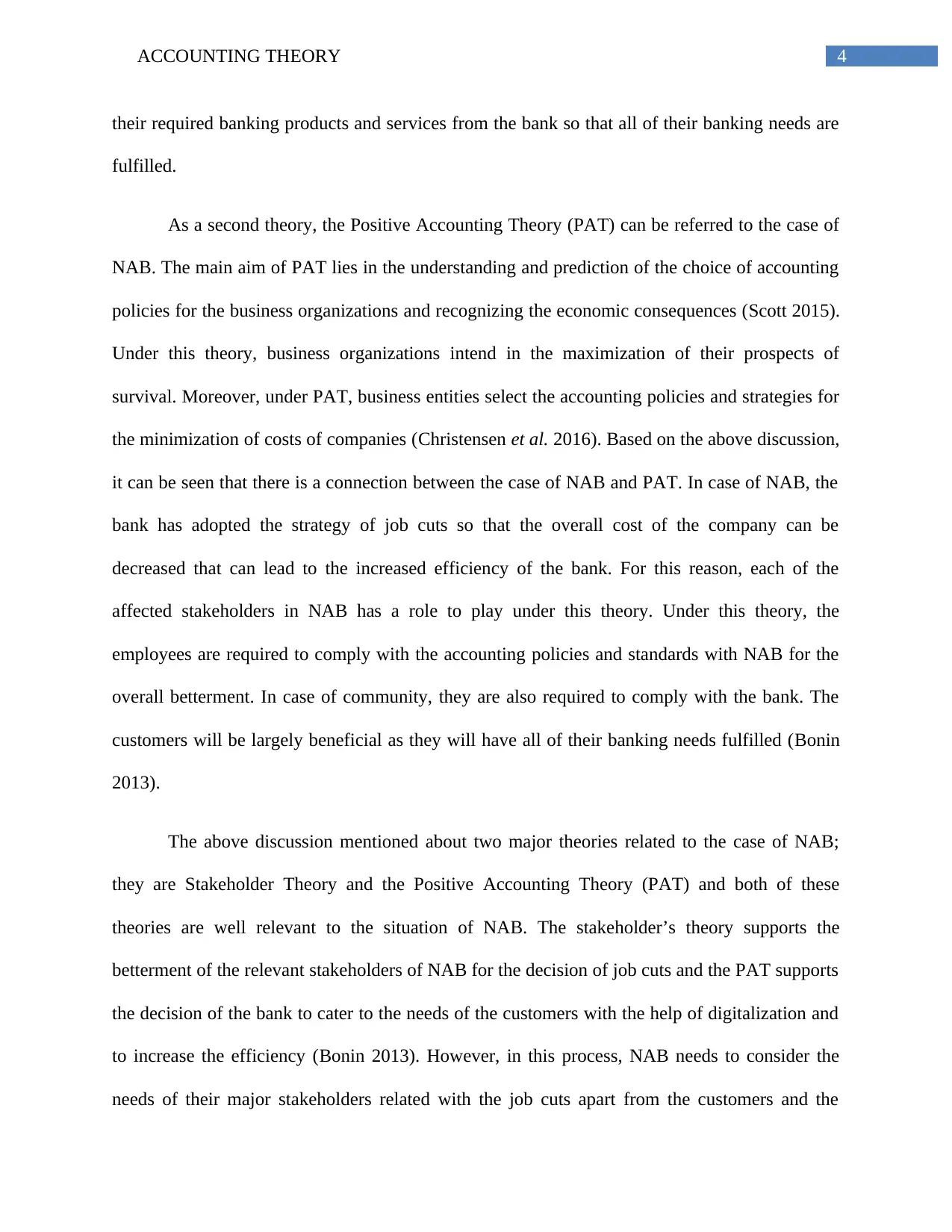
4ACCOUNTING THEORY
their required banking products and services from the bank so that all of their banking needs are
fulfilled.
As a second theory, the Positive Accounting Theory (PAT) can be referred to the case of
NAB. The main aim of PAT lies in the understanding and prediction of the choice of accounting
policies for the business organizations and recognizing the economic consequences (Scott 2015).
Under this theory, business organizations intend in the maximization of their prospects of
survival. Moreover, under PAT, business entities select the accounting policies and strategies for
the minimization of costs of companies (Christensen et al. 2016). Based on the above discussion,
it can be seen that there is a connection between the case of NAB and PAT. In case of NAB, the
bank has adopted the strategy of job cuts so that the overall cost of the company can be
decreased that can lead to the increased efficiency of the bank. For this reason, each of the
affected stakeholders in NAB has a role to play under this theory. Under this theory, the
employees are required to comply with the accounting policies and standards with NAB for the
overall betterment. In case of community, they are also required to comply with the bank. The
customers will be largely beneficial as they will have all of their banking needs fulfilled (Bonin
2013).
The above discussion mentioned about two major theories related to the case of NAB;
they are Stakeholder Theory and the Positive Accounting Theory (PAT) and both of these
theories are well relevant to the situation of NAB. The stakeholder’s theory supports the
betterment of the relevant stakeholders of NAB for the decision of job cuts and the PAT supports
the decision of the bank to cater to the needs of the customers with the help of digitalization and
to increase the efficiency (Bonin 2013). However, in this process, NAB needs to consider the
needs of their major stakeholders related with the job cuts apart from the customers and the
their required banking products and services from the bank so that all of their banking needs are
fulfilled.
As a second theory, the Positive Accounting Theory (PAT) can be referred to the case of
NAB. The main aim of PAT lies in the understanding and prediction of the choice of accounting
policies for the business organizations and recognizing the economic consequences (Scott 2015).
Under this theory, business organizations intend in the maximization of their prospects of
survival. Moreover, under PAT, business entities select the accounting policies and strategies for
the minimization of costs of companies (Christensen et al. 2016). Based on the above discussion,
it can be seen that there is a connection between the case of NAB and PAT. In case of NAB, the
bank has adopted the strategy of job cuts so that the overall cost of the company can be
decreased that can lead to the increased efficiency of the bank. For this reason, each of the
affected stakeholders in NAB has a role to play under this theory. Under this theory, the
employees are required to comply with the accounting policies and standards with NAB for the
overall betterment. In case of community, they are also required to comply with the bank. The
customers will be largely beneficial as they will have all of their banking needs fulfilled (Bonin
2013).
The above discussion mentioned about two major theories related to the case of NAB;
they are Stakeholder Theory and the Positive Accounting Theory (PAT) and both of these
theories are well relevant to the situation of NAB. The stakeholder’s theory supports the
betterment of the relevant stakeholders of NAB for the decision of job cuts and the PAT supports
the decision of the bank to cater to the needs of the customers with the help of digitalization and
to increase the efficiency (Bonin 2013). However, in this process, NAB needs to consider the
needs of their major stakeholders related with the job cuts apart from the customers and the
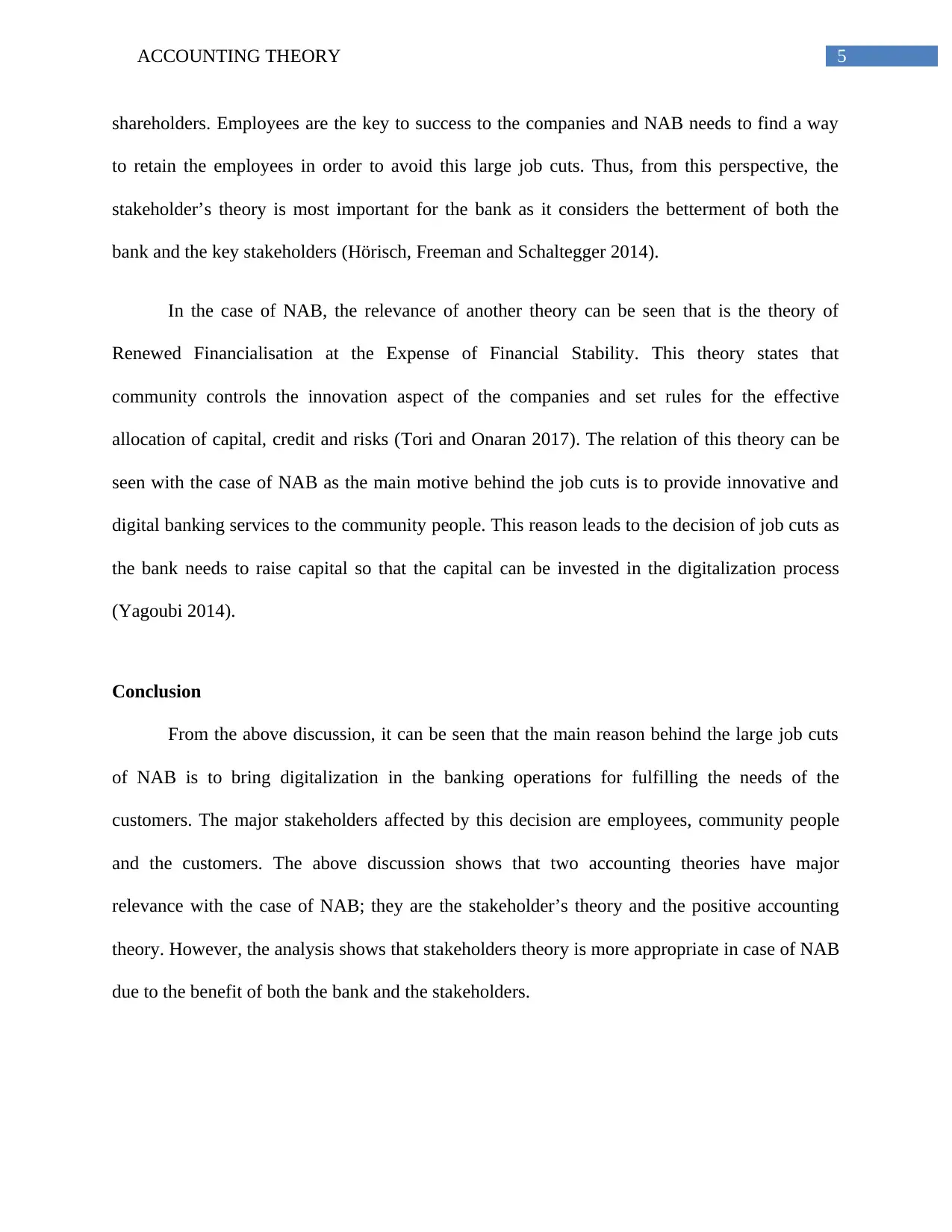
5ACCOUNTING THEORY
shareholders. Employees are the key to success to the companies and NAB needs to find a way
to retain the employees in order to avoid this large job cuts. Thus, from this perspective, the
stakeholder’s theory is most important for the bank as it considers the betterment of both the
bank and the key stakeholders (Hörisch, Freeman and Schaltegger 2014).
In the case of NAB, the relevance of another theory can be seen that is the theory of
Renewed Financialisation at the Expense of Financial Stability. This theory states that
community controls the innovation aspect of the companies and set rules for the effective
allocation of capital, credit and risks (Tori and Onaran 2017). The relation of this theory can be
seen with the case of NAB as the main motive behind the job cuts is to provide innovative and
digital banking services to the community people. This reason leads to the decision of job cuts as
the bank needs to raise capital so that the capital can be invested in the digitalization process
(Yagoubi 2014).
Conclusion
From the above discussion, it can be seen that the main reason behind the large job cuts
of NAB is to bring digitalization in the banking operations for fulfilling the needs of the
customers. The major stakeholders affected by this decision are employees, community people
and the customers. The above discussion shows that two accounting theories have major
relevance with the case of NAB; they are the stakeholder’s theory and the positive accounting
theory. However, the analysis shows that stakeholders theory is more appropriate in case of NAB
due to the benefit of both the bank and the stakeholders.
shareholders. Employees are the key to success to the companies and NAB needs to find a way
to retain the employees in order to avoid this large job cuts. Thus, from this perspective, the
stakeholder’s theory is most important for the bank as it considers the betterment of both the
bank and the key stakeholders (Hörisch, Freeman and Schaltegger 2014).
In the case of NAB, the relevance of another theory can be seen that is the theory of
Renewed Financialisation at the Expense of Financial Stability. This theory states that
community controls the innovation aspect of the companies and set rules for the effective
allocation of capital, credit and risks (Tori and Onaran 2017). The relation of this theory can be
seen with the case of NAB as the main motive behind the job cuts is to provide innovative and
digital banking services to the community people. This reason leads to the decision of job cuts as
the bank needs to raise capital so that the capital can be invested in the digitalization process
(Yagoubi 2014).
Conclusion
From the above discussion, it can be seen that the main reason behind the large job cuts
of NAB is to bring digitalization in the banking operations for fulfilling the needs of the
customers. The major stakeholders affected by this decision are employees, community people
and the customers. The above discussion shows that two accounting theories have major
relevance with the case of NAB; they are the stakeholder’s theory and the positive accounting
theory. However, the analysis shows that stakeholders theory is more appropriate in case of NAB
due to the benefit of both the bank and the stakeholders.
⊘ This is a preview!⊘
Do you want full access?
Subscribe today to unlock all pages.

Trusted by 1+ million students worldwide
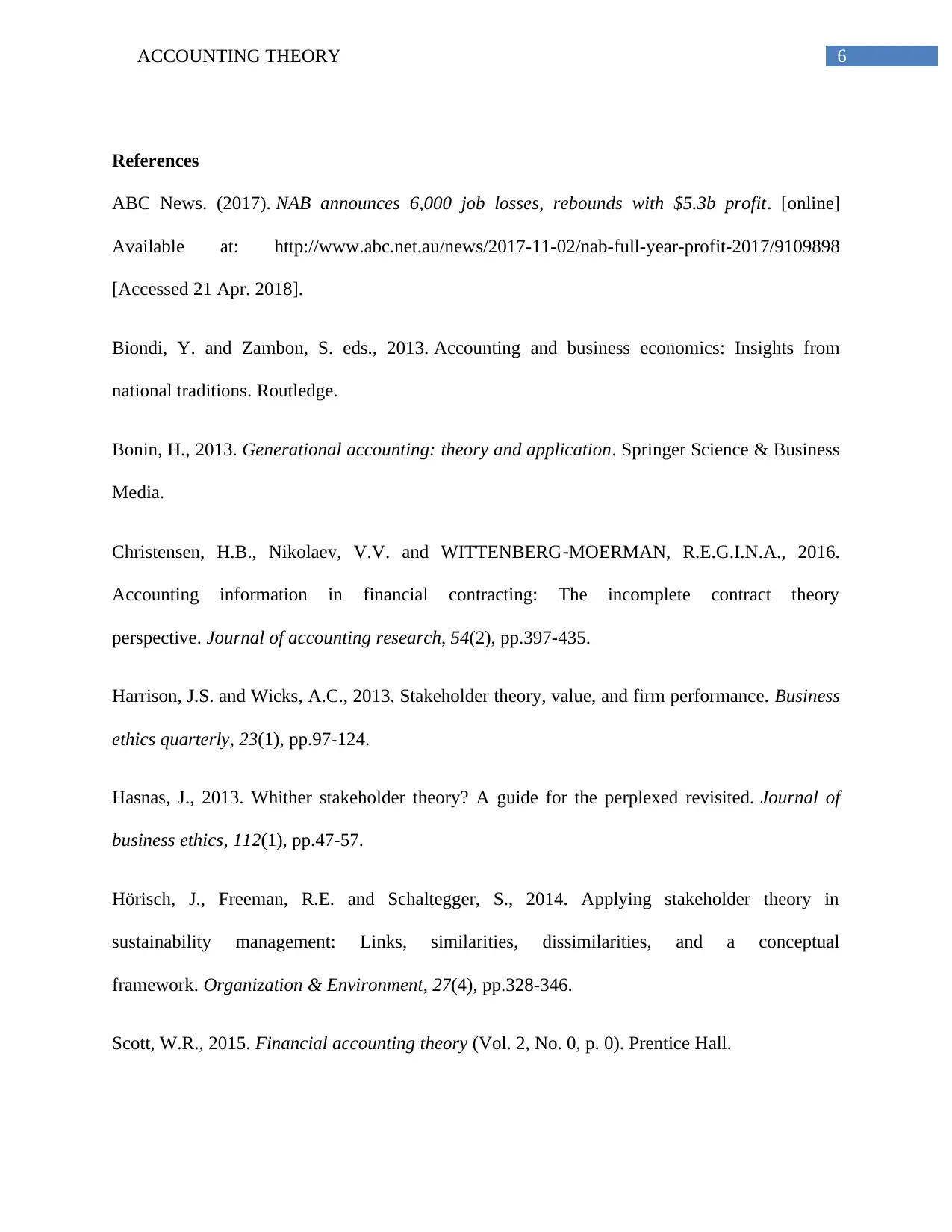
6ACCOUNTING THEORY
References
ABC News. (2017). NAB announces 6,000 job losses, rebounds with $5.3b profit. [online]
Available at: http://www.abc.net.au/news/2017-11-02/nab-full-year-profit-2017/9109898
[Accessed 21 Apr. 2018].
Biondi, Y. and Zambon, S. eds., 2013. Accounting and business economics: Insights from
national traditions. Routledge.
Bonin, H., 2013. Generational accounting: theory and application. Springer Science & Business
Media.
Christensen, H.B., Nikolaev, V.V. and WITTENBERG‐MOERMAN, R.E.G.I.N.A., 2016.
Accounting information in financial contracting: The incomplete contract theory
perspective. Journal of accounting research, 54(2), pp.397-435.
Harrison, J.S. and Wicks, A.C., 2013. Stakeholder theory, value, and firm performance. Business
ethics quarterly, 23(1), pp.97-124.
Hasnas, J., 2013. Whither stakeholder theory? A guide for the perplexed revisited. Journal of
business ethics, 112(1), pp.47-57.
Hörisch, J., Freeman, R.E. and Schaltegger, S., 2014. Applying stakeholder theory in
sustainability management: Links, similarities, dissimilarities, and a conceptual
framework. Organization & Environment, 27(4), pp.328-346.
Scott, W.R., 2015. Financial accounting theory (Vol. 2, No. 0, p. 0). Prentice Hall.
References
ABC News. (2017). NAB announces 6,000 job losses, rebounds with $5.3b profit. [online]
Available at: http://www.abc.net.au/news/2017-11-02/nab-full-year-profit-2017/9109898
[Accessed 21 Apr. 2018].
Biondi, Y. and Zambon, S. eds., 2013. Accounting and business economics: Insights from
national traditions. Routledge.
Bonin, H., 2013. Generational accounting: theory and application. Springer Science & Business
Media.
Christensen, H.B., Nikolaev, V.V. and WITTENBERG‐MOERMAN, R.E.G.I.N.A., 2016.
Accounting information in financial contracting: The incomplete contract theory
perspective. Journal of accounting research, 54(2), pp.397-435.
Harrison, J.S. and Wicks, A.C., 2013. Stakeholder theory, value, and firm performance. Business
ethics quarterly, 23(1), pp.97-124.
Hasnas, J., 2013. Whither stakeholder theory? A guide for the perplexed revisited. Journal of
business ethics, 112(1), pp.47-57.
Hörisch, J., Freeman, R.E. and Schaltegger, S., 2014. Applying stakeholder theory in
sustainability management: Links, similarities, dissimilarities, and a conceptual
framework. Organization & Environment, 27(4), pp.328-346.
Scott, W.R., 2015. Financial accounting theory (Vol. 2, No. 0, p. 0). Prentice Hall.
Paraphrase This Document
Need a fresh take? Get an instant paraphrase of this document with our AI Paraphraser
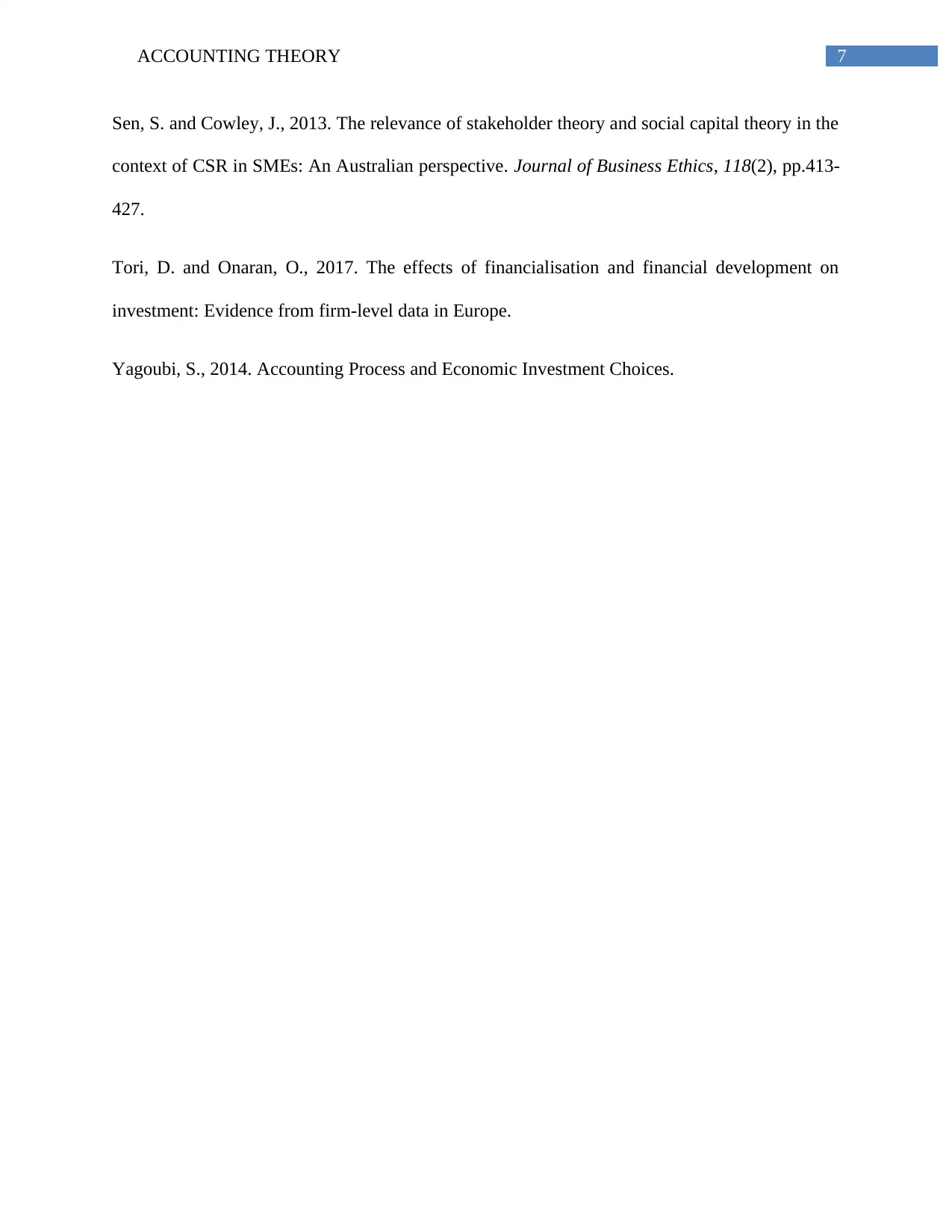
7ACCOUNTING THEORY
Sen, S. and Cowley, J., 2013. The relevance of stakeholder theory and social capital theory in the
context of CSR in SMEs: An Australian perspective. Journal of Business Ethics, 118(2), pp.413-
427.
Tori, D. and Onaran, O., 2017. The effects of financialisation and financial development on
investment: Evidence from firm-level data in Europe.
Yagoubi, S., 2014. Accounting Process and Economic Investment Choices.
Sen, S. and Cowley, J., 2013. The relevance of stakeholder theory and social capital theory in the
context of CSR in SMEs: An Australian perspective. Journal of Business Ethics, 118(2), pp.413-
427.
Tori, D. and Onaran, O., 2017. The effects of financialisation and financial development on
investment: Evidence from firm-level data in Europe.
Yagoubi, S., 2014. Accounting Process and Economic Investment Choices.
1 out of 8
Related Documents
Your All-in-One AI-Powered Toolkit for Academic Success.
+13062052269
info@desklib.com
Available 24*7 on WhatsApp / Email
![[object Object]](/_next/static/media/star-bottom.7253800d.svg)
Unlock your academic potential
Copyright © 2020–2025 A2Z Services. All Rights Reserved. Developed and managed by ZUCOL.




